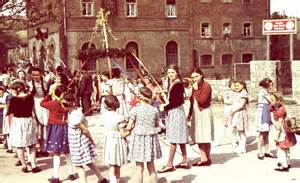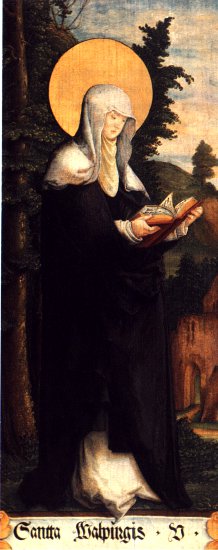Today is the 1st of May, or May Day, a public holiday and celebration of spring in many countries throughout the world. Growing up in the United States, where this festival is not widely observed, I have been ignorant of its traditions and spiritual roots until quite recently. May Day has its roots mostly in northern Europe as an ancient celebration of the coming of spring, rebirth and fertility. In the 20th century, May Day became widely known as International Workers’ Day, first in Socialist countries and then spreading throughout the world. Today it is a public holiday in 80 countries and is observed as a day off of work and school to celebrate the accomplishments of the working class, similar to the September observance of Labor Day in the United States and Canada.
May Day an ancient celebration of the coming of spring, rebirth and fertility.
 I had heard my grandmother and great-aunt, now in their 90’s, speak about the May Day celebrations of their youth, but it was not until I was in my twenties and began to travel abroad that I learned of the widespread observance of this day and it’s spiritual roots. In the Anglosphere many May Day traditions have their origins in the ancient pre-Christian festival of Beltane once widely celebrated in Britain and Ireland. On this night, people would extinguish their hearth fires and throughout the countryside Celtic priests would light sacred bonfires from which people would relight the home fires to bring luck, fertility and prosperity into their lives. The flames, ashes and embers from these fires were considered to be sacred. Today many neo-Pagan religions have revived the tradition of the sacred fires of Beltane, although such fires nowadays are more associate with St. John’s Eve, or the Summer solstice which occurs in late June.
I had heard my grandmother and great-aunt, now in their 90’s, speak about the May Day celebrations of their youth, but it was not until I was in my twenties and began to travel abroad that I learned of the widespread observance of this day and it’s spiritual roots. In the Anglosphere many May Day traditions have their origins in the ancient pre-Christian festival of Beltane once widely celebrated in Britain and Ireland. On this night, people would extinguish their hearth fires and throughout the countryside Celtic priests would light sacred bonfires from which people would relight the home fires to bring luck, fertility and prosperity into their lives. The flames, ashes and embers from these fires were considered to be sacred. Today many neo-Pagan religions have revived the tradition of the sacred fires of Beltane, although such fires nowadays are more associate with St. John’s Eve, or the Summer solstice which occurs in late June.
 In Germany and Scandinavia, the similar celebration of Walpurgis Night occurs on the night of April 30th into May 1st. It is named after St. Walpurga, a 7th century missionary from the British Isles whose feast day happens to fall of the 1st of May. In the past, it was common to play pranks on people, decorate houses with spring greens and share treats, much in line with modern day Halloween practices. In the 17th and 18th century, Walpurgis Night had a reputation of being the major witches’ Sabbath, on which witches gathered in the countryside to perform communal rituals. Today Walpurgis Night is a time to gather with friends, enjoy huge bonfires, barbecue and drink massive qualities of alcohol!
In Germany and Scandinavia, the similar celebration of Walpurgis Night occurs on the night of April 30th into May 1st. It is named after St. Walpurga, a 7th century missionary from the British Isles whose feast day happens to fall of the 1st of May. In the past, it was common to play pranks on people, decorate houses with spring greens and share treats, much in line with modern day Halloween practices. In the 17th and 18th century, Walpurgis Night had a reputation of being the major witches’ Sabbath, on which witches gathered in the countryside to perform communal rituals. Today Walpurgis Night is a time to gather with friends, enjoy huge bonfires, barbecue and drink massive qualities of alcohol!
Many of the traditional observances of May Day have fallen away. In some areas the custom of erecting an ornate May Pole streaming with colorful ribbons continues, no doubt a throwback to pre-Christian times when the May Pole served as a symbol of prosperity and fertility. In some locations, the day has taken on Carnival-like aspects which in which people gather to celebrate with food, music, concerts and even crown a May Queen, much like the Queen of Mardi Gras Balls in New Orleans. In the Philippines, and indeed all of the Catholic world, the entire month of May is dedicated to the Virgin Mary, and children pick wildflowers on their way to school and lay them on the altar of the Blessed Mother. Since the early 20th century, the 1st of May is most widely observed around the world as Labor Day, a day to relax and enjoy time with family and friends.
Thank you for taking the time to read my blog and I hope you are enjoying your own May Day, if you celebrate it, and if not, I hope you are enjoying the beauty and sacredness of spring! Until next time, may peace and blessings rain down upon yo